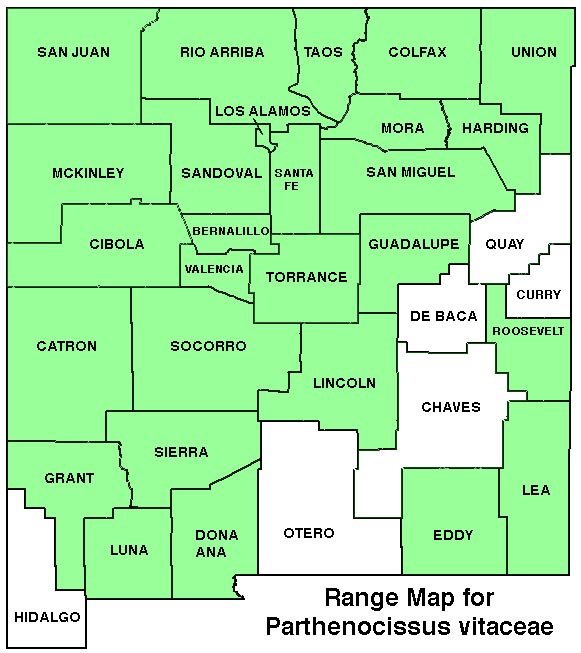WILDFLOWERS OF NEW MEXICO

High-climbing or a sprawling groundcover, this woody vine has densely branching stems reaching 15 feet long. The tiny, inconspicuous flowers attract bees, and birds feast on the abundant fleshy berries. The compound leaves have 5 leaflets spreading from a central point. Note the twining tendrils do not have disk-like tips. The flower/fruit clusters branch by forking equally twice repeatedly, so the cluster has no central axis. Once lumped with Virginia creeper, P. quinquefolia, woodbine’s accepted species name is still unresolved.
FLOWER: May–June. Clusters 3–6 inches long with 10–75 tiny, greenish-yellow flowers, each 1/4 inch wide (6 mm) with 5 petals; fruit a fleshy, blue-black berry 1/4–3/8 inch diameter (6–10 mm). Note the cluster forks into paired branches, which continue to fork in pairs, so the cluster has no central axis.
LEAVES: Alternate, palmate with 5 leaflets. Blades oval to elliptic, 1 1/2–4 inches long (4–10 cm), tips pointed; margins toothed, top surface shiny when fresh. Tendrils branch 2–5 times, each 1 1/2–6 inches long (3.8–15 cm); tip nonadhesive, twines around vegetation, wedges into cracks and expands for a tight grip; adhesive disk-like tips usually absent. Deciduous leaves turn bright red in fall.
HABITAT: Periodically moist sandy, gravelly soils, stream sides, canyons, slopes; riparian areas, drainages, grasslands, pinyon-juniper and ponderosa woodlands.
ELEVATION: 3,600–7,500 feet.
RANGE: AZ, CA, CO, MT, ND, NM, NV, SD, TX, UT, WY; widespread across Great Lakes states through New England, absent Southern and Mid-Atlantic states.
SIMILAR SPECIES: Virginia creeper. P. quinquefolia, native to the Great Plains and eastward, is popular in landscaping and occasionally escapes. It has tendrils with enlarged adhesive, disk-like tips, and the flower stem has a distinctive zigzagging central axis with side branches, and fresh leaflets have a dull upper surface.
NM COUNTIES: Widespread in NM in low- to mid-elevations, moist habitats: Bernalillo, Catron, Cibola, Colfax, Dona Ana, Eddy, Grant, Guadalupe, Harding, Lea, Lincoln, Los Alamos, Luna, McKinley, Mora, Rio Arriba, Roosevelt, San Juan, San Miguel, Sandoval, Santa Fe, Sierra, Socorro, Taos, Torrance, Union, Valencia.
WOODBINE, THICKET CREEPER
PARTHENOCISSUS VITACEA (aka Parthenocissus inserta)
Grape Family, Vitaceae
Perennial, deciduous vine



























THE CONTENTS OF THIS WEBSITE ARE COPYRIGHTED AND CANNOT BE USED
WITHOUT PERMISSION OF GEORGE OXFORD MILLER
















EMAIL ME



























Flower/fruit stems repeatedly divide evenly into two forks so the cluster has no central axis.
The woody vine can climb high in trees, or form a dense groundcover with rooting stems.









Compound leaves have 5 elliptical leaflets with toothed edges and pointed tips. The fruit stems (arrow) and leaves turn brilliant reds in the fall.



















